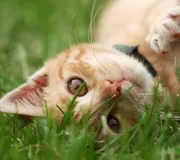Kitties are very mysterious little furballs, who have certainly gathered more than their fair share of myths and legends. In fact, for a cute, innocent-looking pet, Fluffy has amassed a rather impressive collection of urban—and rural—legends. A local vet lists a few of them below.
Cat Goddesses
Our feline friends have been associated with several different goddesses. The most well-known may be Egypt’s Bastet, who was often depicted in feline form. The ancient Greeks had their own kitty goddess, Ailuros, but also associated cats with Artemis and Athena. The Norse goddess Freya drove a chariot pulled by two large felines. The Hindu goddesses Durga and Parvati were also closely associated with big kitties.
Luck
Fluffy has also long been associated with luck, both good and bad. As you may know, black cats have long been considered unlucky in Western mythology. This is actually very unfortunate, as these superstitions continue to this day, and play a role in the low adoption rates of black cats. In other eras and cultures, black kitties have been considered good luck. In some instances, a cat’s luck depends on their coloring. For instance, Buddhist lore states that cats with dark fur bring gold, while lighter-colored furballs bring silver. Russian Blue cats are considered lucky in Russia. In China, luck and age are connected, with older furballs being the most fortunate.
Pussy Willow
The story of the pussy willow is one of the most enduring myths about our feline friends. This tale starts with a litter of playful kittens chasing butterflies on a sunny spring day. Unfortunately, the kittens fell into a river. Their mother, desperate, cried out in distress. Hearing her terrified meows, a willow tree on the riverbank lowered its branches into the water. The kittens grabbed the branches and climbed to safety, sopping wet and crying. According to legend, willow trees have extended branches with furry ‘kitten’ buds every spring since.
Immortality
Last but not least, we have that old adage about cats having nine lives. This one we can state for a fact isn’t true. While some of our patients do have an uncanny ability to escape dangerous situations, this is usually sheer luck. Keep your feline buddy safe and sound indoors. Of course, it won’t hurt to offer your feline overlord soft beds, fun toys, treats, and catnip.
Our Advice on Feline Folklore in 2024
How are cats connected to goddesses?
Cats are intricately woven into the tapestry of mythology, historically revered and associated with various goddesses across cultures. In Egypt, Bastet, often depicted in feline form, symbolizes protection and domesticity. Ancient Greeks linked cats with goddesses like Artemis and Athena, while the Norse goddess Freya was said to drive a chariot pulled by large cats. In Hinduism, Durga and Parvati are depicted with big felines, reflecting cats’ significance in spirituality and mythology, highlighting their revered status and symbolic representation of feminine power, protection, and mystery.
How do a cat’s color and age factor into luck beliefs?
In various cultures, a cat’s color and age are believed to influence luck. For instance, black cats are considered unlucky in Western mythology, impacting their adoption rates, whereas in some traditions, they’re seen as bearers of prosperity. Buddhist lore suggests cats with dark fur bring wealth (gold), while lighter shades promise silver. Russian Blues are deemed lucky in Russia. Additionally, in China, older cats are regarded as more fortunate. These beliefs illustrate how cats’ physical attributes and age are intertwined with notions of luck and fortune across different societies.
What might cats symbolize within these myths?
Within these myths, cats symbolize a wide range of qualities, from divine protection and luck to resilience and mystery. Historically revered alongside goddesses, they embody feminine power and spirituality. The luck associated with cats, varying by color and age, reflects cultural beliefs in fortune and prosperity. The tale of the pussy willow illustrates cats’ playfulness and resilience, while the nine lives myth underscores their perceived ability to escape danger, highlighting their symbolic roles in representing adaptability, protection, and the mystical across various cultures.
Are there any common themes or reasons behind the different cat-related myths?
Common themes in cat-related myths include reverence, protection, and the mystical. Cats’ association with goddesses across cultures speaks to their revered status and symbolic representation of feminine power. Myths about cats bringing luck, both good and bad, highlight their role in cultural beliefs about fortune. The enduring tale of the pussy willow showcases their resilience and the protective instincts of motherhood. Overall, these myths underscore cats’ perceived mystical qualities, their adaptability, and their deep-rooted significance in human society as symbols of mystery, protection, and spirituality.
Do these ancient myths still influence how people view cats today?
Yes, ancient myths continue to influence contemporary views on cats, shaping perceptions of their mystical qualities and roles within households. The reverence of cats in ancient cultures as divine entities or symbols of luck has transcended time, manifesting in modern superstitions and beliefs. For instance, black cats are still associated with luck—good or bad—depending on cultural context. Additionally, the protective and revered status of cats in myths contributes to their cherished position as pets, reflecting a continued belief in their unique, almost magical qualities and their ability to bring fortune or protection to their owners.
Do you have questions about your cat’s health or care? Contact us, your animal clinic in St. Lucie County, FL, today!

